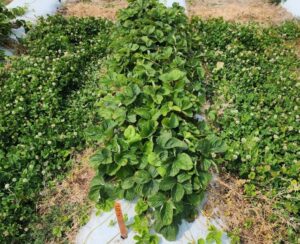As strawberry harvest winds down, attention turns to strawberry renovation.
Renovation consists of mowing existing strawberry foliage (Figure 1) and, in matted row systems, cultivating to reduce row width. When combined with strategic herbicide applications, this can be a great time in the production cycle to catch up on weed management or maintain your level of weed control. One way to break down the weed management options is by weed life cycle.
- Figure 1. Mechanical renovation of plasticulture strawberry plants at Meigs Horticulture Research Farm, Lafayette, IN. Photo by Jeanine Arana
- Manual renovation of plasticulture strawberry plants at Meigs Horticulture Research Farm, Lafayette, IN. Photo by Jeanine Arana
Winter annuals:
If you have escaped winter annual weeds like field pennycress, henbit, or chickweed, they should have seeded out and died back by now. Mowing and cultivating will remove what’s left. If your control of winter annuals this year was less than desirable, consider a fall pre-emergence herbicide application. More on this in a future issue.
Perennials/Biennials:
If perennial weeds are growing above the strawberry canopy, consider a post-emergence herbicide application prior to mowing. 2,4-D amine (Embed® Extra, others) or clopyralid (Stinger®, Spur®) can be used to manage broadleaf weeds while clethodim (SelectMax®, others), sethoxydim (Poast®, others), or fluazifop (Fusilade®) can be used to manage grasses. Clopyralid works well on composite weeds (dandelion, Canada thistle), nightshades, and legumes (clovers). It also works well on Carolina geranium. 2,4-D will provide better control of many other perennial broadleaf weeds. Clethodim generally provides the best control of perennial grasses with the exception of quackgrass, which is best controlled with fluazifop. Grass herbicide application should include an appropriate non-ionic surfactant or crop oil to facilitate herbicide uptake. If applications are made prior to mowing, allow several days between application and mowing. This gives ample time for these systemic herbicides to be absorbed into the weeds and moved to the growing points.
Annuals:
In well-canopied matted row strawberries, annual weeds are generally out-competed by the established strawberry plants in the spring. However, mowing at renovation opens a window for weed emergence and growth. Pre-emergence herbicides can help to prevent weed emergence while strawberries regrow. Pre-emergence herbicides should be applied to a weed-free soil surface, for example immediately following cultivation. S-metolachlor (Dual Magnum®), pendimethalin* (Prowl® H20, others), terbacil (Sinbar®), and acifluorfen (Ultra Blazer®) can be applied over-the-top of rows and row middles of matted row strawberries at renovation. S-metolachlor, pendimethalin*, acifluorfen, flumioxazin (Chateau®), napropamide* (Devrinol®), and bicyclopyrone (Optogen®) can be applied as directed applications to row middles in plasticulture systems. Tank-mixing combinations of these products can improve the spectrum of weeds controlled. Consult product labels for more information. Strawberry cultivars differ in their tolerance to terbacil. To reduce the risk of injury, apply terbacil just prior to a rainfall or overhead irrigation event, and do not apply terbacil on soils with less than 0.5% organic matter. All pre-emergence herbicides will require rainfall or overhead irrigation for activation- to move the herbicide into the soil where weed seeds are actively germinating.
In plasticulture strawberry, emerged annual weeds can be managed with row-middle applications of carfentrazone (Aim®), paraquat (Gramoxone®), glyphosate (Roundup®), or pelargonic acid (Scythe®). Carfentrazone, paraquat, and pelargonic acid are contact herbicides, “burning” green tissues they contact. They work best on small weeds and require adequate spray coverage. Glyphosate is systemic. Although it can be effective on larger weeds, it also has greater potential to injure strawberry plants if it drifts into the row or comes in contact with runners in the row middles. For this reason, we generally discourage using glyphosate in row middles during the growing season. Include non-ionic surfactant or crop oil according to the product label. Ammonium sulfate may also be necessary when hard water is used.
A Note on Strawberry Herbicides and Carryover:
If you plan to take strawberries out of production following the 2024 season, be mindful of rotation restrictions of the herbicides referenced above. Sinbar® has a two-year rotation restriction for most crops. Clopyralid (Stinger®, Spur®) rotation restrictions vary from “anytime” for (cole crops and sweet corn) to 18 months for peas and potatoes.
Non-Herbicide Options:
For those who choose to grow without using chemical weed control, straw can be used to mulch row middles following mowing and/or cultivation. In plasticulture production systems, row middles can be planted with low-growing cover crops (such as white clover) (Figure 2). We are currently researching both chemical and non-chemical row middle weed control in multi-year plasticulture strawberry production systems and look forward to sharing our results in the future and at these upcoming field days:
Purdue Fruit and Vegetable Field Day. July 20, 2023. Meigs Farm. Lafayette, IN. Purdue Fruit & Vegetable Field Day 2023 | Purdue University Facts for Fancy Fruit
Southwest Purdue Agriculture Center Field Day. June 28, 2023. Vincennes, IN. Southwest Purdue Agricultural Center Field Day Registration Open | Purdue University Vegetable Crops Hotline (vegcropshotline.org)


